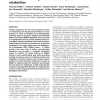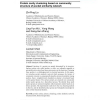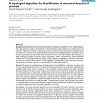160 search results - page 3 / 32 » Towards an automatic classification of protein structural do... |
NAR
2008
13 years 6 months ago
2008
Protein sequences are the most important source of evolutionary and functional information for new proteins. In order to facilitate the computationally intensive tasks of sequence...
RECOMB
2003
Springer
14 years 6 months ago
2003
Springer
It is shown that structural similarity between proteins can be decided well with much less information than what is used in common similarity measures. The full C representation c...
BMCBI
2004
13 years 6 months ago
2004
Background: It is a major challenge of computational biology to provide a comprehensive functional classification of all known proteins. Most existing methods seek recurrent patte...
IJBRA
2008
13 years 6 months ago
2008
: Functions of a protein are mainly determined by its structure. Surface cavities, also called pockets or clefts, are ordinarily regarded as potentially active sites where the prot...
BMCBI
2007
13 years 6 months ago
2007
Background: Identification of the structural domains of proteins is important for our understanding of the organizational principles and mechanisms of protein folding, and for ins...



